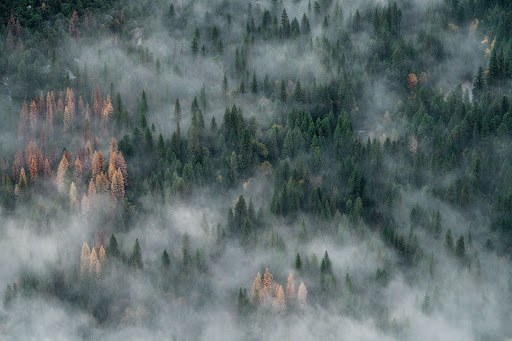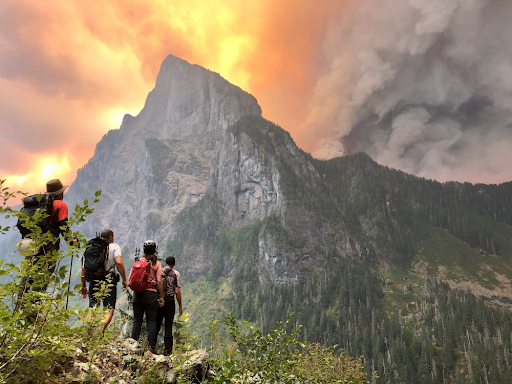
Throughout the Pacific Northwest, recreationists are facing a new reality: wildfires are impacting outdoor recreation more than ever before. From smoky skies to long-term trail closures, fire season is no longer an occasional disruption, but a defining part of the summer outdoor experience.
This year, significant staffing cuts across the U.S. Forest Service and National Park Service are expected to limit the agencies’ ability to respond quickly and effectively to wildfires. As we enter another hot, dry season, reduced workforce capacity heightens risks to both recreationists and the public lands we rely on.
To get our community ready for the upcoming fire season, we shared tips for wildfire-smart recreation in a recent Leadership Development Series presentation on wildfires in the Pacific Northwest. In this evolving environment, it’s more important than ever for outdoor enthusiasts to understand the realities of recreating on fire-prone lands.
The Escalating Fire Crisis
Across the western United States, climate change is fueling extreme fire conditions. Longer, hotter, and drier summers have turned many forests into tinderboxes, where a single spark can ignite fast-moving, high-intensity fires that race across landscapes. These fires threaten wildlife, degrade air quality, and cut off access to the public lands we depend on for recreation.
Climate change is only part of the story. For thousands of years, Indigenous peoples across North America used cultural burning practices to prevent the buildup of forest fuels, dry ground debris like twigs and mid-size trees that allow wildfires to burn quickly and travel from the forest floor to the canopy. Unfortunately, colonization and the rise of federal fire suppression policies disrupted these traditional practices, leading to a fuel buildup in forests. When combined with decades of commercial logging that targeted large, fire-resistant trees, today’s forests are denser, drier, and far more flammable than ever.
Recreation in a Fire-Prone Era
For outdoor enthusiasts, the growing intensity and frequency of wildfires are reshaping how and when we access public lands. Wildfires can destroy trails, bridges, climbing areas, and other recreation infrastructure. Over the past five years, wildfires have damaged more than 23,000 miles of trails across the West, including hundreds of miles here in Washington. While large wildfires have long impacted Eastern Washington, events like the 2022 Bolt Creek Fire - which scorched over 14,000 acres in Western Washington - signal a troubling new normal for the west side of the Cascades.
Wildfire smoke is another serious issue for recreationists. Smoke can travel hundreds or even thousands of miles from an active fire, posing serious health risks to communities throughout the state.

Land Manager Cuts and Wildfire
Recent staffing cuts and a wave of early retirements in the U.S. Forest Service and National Park Service have further strained already overburdened fire management efforts. While most full-time firefighting positions were retained, many of those let go were certified to assist in emergency wildfire operations. Their absence means fewer trained personnel are available to respond to what is expected to be another season of large and intense wildfires.
The Mt. Baker-Snoqualmie National Forest, the most visited national forest in the United States, offers a stark example. Between the 2025 staffing cuts and a seasonal hiring freeze, the Forest lost 70% of its recreation staff - most of whom were qualified to support wildland fire operations. This dramatic reduction has left the Forest with a diminished capacity to support firefighting efforts.
Across the region, similar staffing shortfalls are jeopardizing the ability of federal agencies to manage wildfire risks effectively. As the summer fire season approaches, we’re concerned that the loss of experienced personnel will impact public safety, natural resources, and the long-term resilience of public lands.
Leading Fire-Smart Trips: Tips and Tricks
Preparing for wildfire season today means much more than just checking the weather - it requires a proactive, informed approach that begins well before you leave home. During the 2025 Leadership Development Series, staff highlighted why wildfire awareness is now essential - and how our community can adapt to stay safe and responsible in a fire-prone landscape. Here’s a streamlined guide to help you plan fire-smart trips this summer:
Pre-Trip Planning:
- Monitor fire danger levels and active wildfires using trusted sources like the National Interagency Fire Center, InciWeb, and Watch Duty.
- Check local land manager websites for area-specific closures and fire warnings.
- Review air quality forecasts and adjust your destination plans if smoke is heavy.
- Map escape routes and identify potential safety zones before your trip.
- Ask your lawmakers to advocate against dangerous staffing cuts to the Forest Service and Park Service. A well-staffed workforce is one of our best defenses against destructive wildfires.
Out on the Trail:
- Stay alert to changing weather and smoke conditions at all times.
- Be flexible: turn around early or change plans if fire risk increases.
- If you see smoke, assess its direction and speed, and don’t assume it’s a distant threat.
- If leading a group, monitor group health by watching for signs of smoke-related health issues.
- Recreate responsibly - follow burn bans and campfire restrictions.
Wildfire is a defining part of outdoor recreation in the Pacific Northwest. Whether you're leading a Mountaineers trip or adventuring solo, staying informed and modeling fire-smart behavior helps keep our outdoor spaces safe and accessible. With the right mindset and tools, we can adapt to fire-season realities while still enjoying the outdoors responsibly.
 The Mountaineers
The Mountaineers